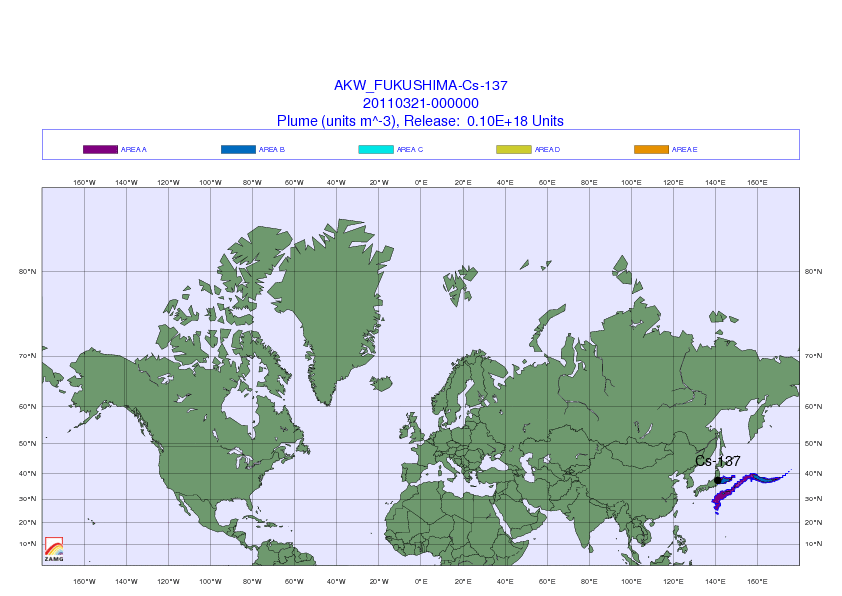Apologists for the type of old, unsafe nuclear reactors which are leaking in Japan argue that the amount of radiation released from Fukushima is small compared to the amount of "background radiation".
There Are NO Background Levels of Radioactive Caesium or Iodine
Wikipedia provides some details on the distribution of cesium-137 due to human activities:
Small amounts of caesium-134 and caesium-137 were released into the environment during nearly all nuclear weapon tests and some nuclear accidents, most notably the Chernobyl disaster. As of 2005, caesium-137 is the principal source of radiation in the zone of alienation around the Chernobyl nuclear power plant. Together with caesium-134, iodine-131, and strontium-90, caesium-137 was among the isotopes with greatest health impact distributed by the reactor explosion.
The mean contamination of caesium-137 in Germany following the Chernobyl disaster was 2000 to 4000 Bq/m2. This corresponds to a contamination of 1 mg/km2 of caesium-137, totaling about 500 grams deposited over all of Germany.Caesium-137 is unique in that it is totally anthropogenic. Unlike most other radioisotopes, caesium-137 is not produced from its non-radioactive isotope, but from uranium. It did not occur in nature before nuclear weapons testing began. By observing the characteristic gamma rays emitted by this isotope, it is possible to determine whether the contents of a given sealed container were made before or after the advent of atomic bomb explosions. This procedure has been used by researchers to check the authenticity of certain rare wines, most notably the purported "Jefferson bottles".
As the EPA notes:
Cesium-133 is the only naturally occurring isotope and is non-radioactive; all
other isotopes, including cesium-137, are produced by human activity.
So there was
no "background radiation" for caesium-137 before above-ground nuclear testing and nuclear accidents such as Chernobyl.
Japan has already, according to some estimates, released 50% of the amount of caesium-137 released by Chernobyl, and many experts say that the Fukushima plants will keep on leaking for months. See this and this. The amount of radioactive fuel at Fukushima dwarfs Chernobyl.
Likewise, iodine-131 is not a naturally occurring isotope. As the Encyclopedia Britannica notes:
The only naturally occurring isotope of iodine is stable iodine-127. An exceptionally useful radioactive isotope is iodine-131...
And New Scientist reports that huge quantities of iodine-131 are being released in Japan:
Austrian researchers have used a worldwide network of radiation detectors – designed to spot clandestine nuclear bomb tests – to show that iodine-131 is being released at daily levels 73 per cent of those seen after the 1986 disaster.
(Indeed, some experts are saying that the amount of radioactivity released in Japan
already exceeds Chernobyl.)
Naturally-Occurring Radiation
There are, of course, naturally occurring radioactive materials.
But lumping all types of radiation together is misleading ... and is comparing apples to oranges.
As the National Research Council's Committee to Assess the Scientific Information for the Radiation Exposure Screening and Education Program explains:
Radioactivity generates radiation by emitting particles. Radioactive materials outside the the body are called external emitters, and radioactive materials located within the body are called internal emitters.
Internal emitters are much more dangerous than external emitters. Specifically, one is only exposed to radiation as long as he or she is
near the external emitter.
For example, when you get an x-ray, an external emitter is turned on for an instant, and then switched back off.
But internal emitters steadily and continuously emit radiation for as long as the particle remains radioactive, or until the person dies - whichever occurs first. As such, they are much more dangerous.
Dr. Helen Caldicott and many other medical doctors and scientists have confirmed this. See
this and
this.
As Hirose Takashi
notes:
All of the information media are at fault here I think. They are saying stupid things like, why, we are exposed to radiation all the time in our daily life, we get radiation from outer space. But that’s one millisievert per year. A year has 365 days, a day has 24 hours; multiply 365 by 24, you get 8760. Multiply the 400 millisieverts by that, you get 3,500,000 the normal dose. You call that safe? And what media have reported this? None. They compare it to a CT scan, which is over in an instant; that has nothing to do with it. The reason radioactivity can be measured is that radioactive material is escaping. What is dangerous is when that material enters your body and irradiates it from inside. These industry-mouthpiece scholars come on TV and what to they say? They say as you move away the radiation is reduced in inverse ratio to the square of the distance. I want to say the reverse. Internal irradiation happens when radioactive material is ingested into the body. What happens? Say there is a nuclear particle one meter away from you. You breathe it in, it sticks inside your body; the distance between you and it is now at the micron level. One meter is 1000 millimeters, one micron is one thousandth of a millimeter. That’s a thousand times a thousand: a thousand squared. That’s the real meaning of “inverse ratio of the square of the distance.” Radiation exposure is increased by a factor of a trillion. Inhaling even the tiniest particle, that’s the danger. [Interviewer] So making comparisons with X-rays and CT scans has no meaning. Because you can breathe in radioactive material.
[Takashi] That’s right. When it enters your body, there’s no telling where it will go. The biggest danger is women, especially pregnant women, and little children. Now they’re talking about iodine and cesium, but that’s only part of it, they’re not using the proper detection instruments. What they call monitoring means only measuring the amount of radiation in the air. Their instruments don’t eat. What they measure has no connection with the amount of radioactive material. . . .
There are few natural high-dose internal emitters. Bananas, brazil nuts and some other foods contain radioactive
potassium-40, but in
extremely low doses.
As the American Journal of Public Health
noted in 1962:
Of the radioisotopes originally present in rock-type formations, some may become internal emitters through natural processes. They may be leached or dissolved into ground and surface waters, thus gaining access to man's water and food supply. For either physical or biological reasons, only a few of the naturally radioactive heavy atoms are important sources of internal radiation exposure. The three most important are believed to be radium 226, the most abundant natural isotope of radium; lead 210, a daughter of radium 226 and of radon 222, and radium 228, a daughter of natural thorium.
Radon 222 has a half life of
less than 4 days. Radium has a much longer half-life. However,radium ions do not form complexes easily, due to highly basic character of ions. Radium compounds are
quite rare, occurring almost exclusively in uranium ores.
Some parts of the country are at higher risk of exposure to naturally-occurring radium than others. It is not only those built on top of uranium mines. For example, the American Journal of Public Health article notes:
Water derived from surface sources such as rivers, lakes, or wells penetrating unconsolidated sand or gravel deposits were, in general, found to contain considerably lower concentrations of radium 226 than wells penetrating deep sandstone formations of Cambrian or pre-Cambrian ages.
In contrast, cesium-137 - one of the main types of radioactivity being spewed by the Japanese plants - has a much longer half life, and can easily contaminate food and water supplies. As the New York Times
noted recently:
Over the long term, the big threat to human health is cesium-137, which has a half-life of 30 years.
At that rate of disintegration, John Emsley wrote in “Nature’s Building Blocks” (Oxford, 2001), “it takes over 200 years to reduce it to 1 percent of its former level.”
It is cesium-137 that still contaminates much of the land in Ukraine around the Chernobyl reactor.
***
Cesium-137 mixes easily with water and is chemically similar to potassium. It thus mimics how potassium gets metabolized in the body and can enter through many foods, including milk.
As the EPA notes in a discussion entitled " What can I do to protect myself and my family from cesium-137?":
Cesium-137 that is dispersed in the environment, like that from atmospheric testing, is impossible to avoid.
Radioactive iodine can also become a potent internal emitter. As the Times notes:
Iodine-131 has a half-life of eight days and is quite dangerous to human health. If absorbed through contaminated food, especially milk and milk products, it will accumulate in the thyroid and cause cancer.
The bottom line is that there is some naturally-occurring background radiation, which can - at times - pose a health hazard (especially in parts of the country with high levels of radioactive radon or radium).
But cesium-137 and radioactive iodine - the two main radioactive substances being spewed by the leaking Japanese nuclear plants - are not naturally-occurring substances, and can become powerful internal emitters which can cause tremendous damage to the health of people who are unfortunate enough to breathe in even a particle of the substances, or ingest them in food or water. Unlike low-levels of radioactive potassium found in bananas - which our bodies have adapted to over many years - cesium-137 and iodine 131 are brand new, extremely dangerous substances.
And unlike naturally-occurring internal emitters like radon and radium - whose distribution is largely concentrated in certain areas of the country - radioactive cesium and iodine are spreading not only nationally, but world-wide.
At the very least, it is important to note that each individual internal emitters behaves differently. They each accumulate in different places in the body, target different organs, mimic different vitamins and minerals, and are excreted differently (or not at all). Therefore, comparing radioactive cesium or iodine with naturally occurring radioactive substances - even those which can become internal emitters - is incorrect and misleading.
This is not to say that we're all going to get cancer. Most of use probably won't. This is solely an attempt to counter the misleading propaganda from apologists for old, unsafe nuclear reactors. For background information on "safe" radiation levels, see this.











